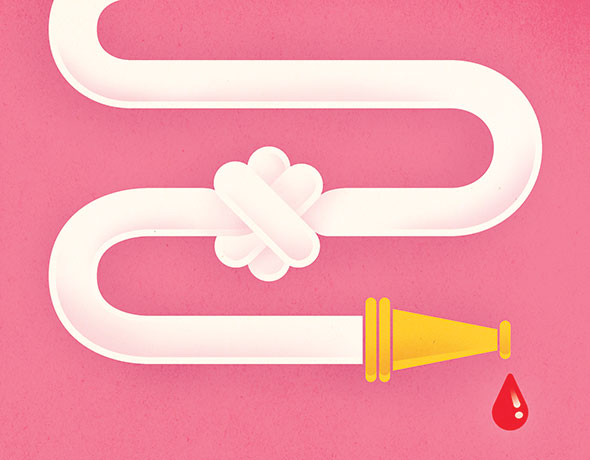
bioengineering
Bloody Brilliant
Undergrad Joe Landolina may revolutionize healing
by Alyson Krueger / GSAS ’12

As a kid, Joe Landolina loved to invent things. Growing up on his grandfather’s vineyard in Pine Bush, New York, he experimented with new wine varieties in the two labs on the property. “It actually takes quite a bit of chemistry to make sure that everything is balanced in a good wine,” Landolina (POLY ’14) explains. “Under my grandfather’s tutelage, [I] learned how to manipulate biochemistry.” He even tried to create aspirin once but admits: “I don’t know how well that went.”
Those early trials, however, set the stage for one very big feat. Now working toward his bachelor’s degree in chemical and biomolecular engineering and, simultaneously, a master’s in biomedical engineering and biomaterials at NYU, Landolina recently went public with an astonishing invention. Called Veti-Gel, the substance stops uncontrollable bleeding cold—something that could benefit everyone from patients in surgery to soldiers on a battlefield. Publications such as The Huffington Post, USA Today, and the New York Daily News have written about Veti-Gel, singing its praises. Landolina and business partner Issac Miller (STERN ’12) have brokered partnerships with doctors and research organizations across the country. All it took to put this in motion was some good old-fashioned competition.
When Landolina arrived at NYU in 2010, he was dazzled by the $175,000 prize he saw advertised for the winner of the Leonard N. Stern School of Business Entrepreneurs Challenge. So he decided to invent something. He called to discuss ideas with his father, a police lieutenant, who suggested he try to help EMS workers save more lives. Being that Landolina once had dreams of becoming a surgeon, he took that a step further and conceived a product that could help medical professionals at all stages of crises.
To move forward, the freshman reconsidered some work from his past. In high school, Landolina had conducted informal experiments with polymers—the molecules that make up our DNA and proteins as well as other substances in the universe—learning how to turn them into solids. So he figured if he could invent a polymer that could act like skin, it just might close wounds and stop bleeding. He went to work reading as many books and papers on the subject as possible and traveling home on weekends to experiment with polymers in his grandfather’s wine labs. Just two weeks later, he had derived a beige gel from a plant that could reassemble to mimic whatever surface it was applied to—including human skin. Veti-Gel was born.
At the time of the Stern competition, the judges viewed Veti-Gel as a glorified Band-Aid, something that could only cover a wound and facilitate healing (he took second place). But Landolina had a hunch that it could do much more. So he went to a local butcher shop in Brooklyn, bought a juicy, fresh pork loin, and sliced it down the middle, producing a great gush of blood. After applying the gel, the rampant bleeding stopped before Landolina’s eyes, and the cut closed within seconds.
He knew he was on to something. After that experiment Landolina reached out to Herbert Dardik, former chief of surgery at Englewood Hospital in New Jersey, who agreed to test Veti-Gel on rats in his lab. Together they performed a 12-animal study over the course of two months. Every time one of the researchers sliced into a liver or punctured an artery, the gel put the organ or pathway back together in seconds—and saved the animal’s life.
Now, Landolina and Miller, whom he met during the Stern competition (they currently operate under the company name Suneris, Inc.), are working to formally produce the product, which they believe will especially benefit veterinarians, the military, and surgeons, but also the general public. Of course, this will require rigorous testing, so the first step is to attract backers who can finance more experiments and make plans for distribution. However, Veti-Gel is already being manufactured for veterinarians; more than 300 have expressed interest in it when it is ready for clinical evaluations later this fall.
Not only does Veti-Gel have a solid business plan, says Kurt Becker, a professor at NYU-Poly, but it also has some advantages that similar products don’t: It’s significantly faster in closing wounds, is much less expensive, and is easy to use (other products require applying pressure, something that isn’t always easy to do in surgery or on a battlefield).
Landolina says that the substance may also be used for other medical tasks. Because it takes on the characteristics of skin and integrates seamlessly into the body, Veti-Gel may be able to deliver medicine to a particular spot or heal burns and other irritations. And the gel is designed to be absorbed into the body, so it never has to be removed (the full effects of the substance on the human body still need to be tested). “Ever since I made the material, it really does surprise me every single day,” Landolina says.
chemistry
Coolness Factor
by Kyla Marshell
This could spell the end of freezer-burned waffles and more: Building on the known behavior of antifreeze proteins found in fish and amphibians living in subzero climates, NYU chemists Kent Kirshenbaum and Michael Ward—along with grad students Mia Huang (GSAS ’09, ’12), David Ehre, Qi Jiang (GSAS ’13), and Chunhua Hu—have synthesized protein-like molecules called peptoids that allowed them to lower the temperature of water significantly below its freezing point of 32° Fahrenheit—while keeping it liquid.
We all know too well that crystals form on month-old ice cream, but they also provide the framework for everything from silicon—an essential component of our most beloved gadgets—to kidney stones and gout. “We want to find out how crystals form, how we can predict the arrangement of individual molecules,” Kirshenbaum explains. “And then we can start to think about how we can alter those events to produce crystalline materials that will be useful to us.” The possibilities range from disease prevention to a new kind of freezing process. Such an innovation would be invaluable for cryo-preservation (the storage of stem cells, biological materials, and other tissues), which currently employs antifreeze solvents that can damage the tissue.
Might this technology be used to freeze the dead in hopes that we could wake them in the future? “It’s not typically what I contemplate as an application for what we’re doing,” Kirshenbaum says. But he adds: “If somebody popped off my head after I passed away, and they were thinking about reanimating it later, I would hope that they care a lot about how it’s being stored.”







